Common menu bar links
Institutional links
Diseases & Conditions
Health & Safety
Research & Statistics
Agency Information
Search Box
E-mail this page
Tuberculosis: Drug resistance in Canada, 2000
Reported susceptibility results of the Canadian Tuberculosis Laboratory Surveillance System
This is a provisional document.
(248 KB) in PDF
Format ![]()
TABLE OF CONTENTS
 RESULTS RESULTS |
|
 DISCUSSION DISCUSSION |
|
 FIGURES FIGURES |
|
| Reported TB drug resistance in Canada by province/territory - 2000 | |
| Reported MTB isolates in Canada by province/territory - 2000 | |
| Overall pattern of reported TB drug resistance in Canada - 2000 | |
| Reported TB drug resistance in Canada by type of drug - 2000 | |
| Reported TB drug resistance in Canada by gender and year of birth - 2000 | |
|
|
|
| Concentrations for routine testing of first-line anti-tuberculosis drugs | |
|
Table 1.
|
Overall pattern of reported TB drug resistance in Canada - 1998-2000 |
|
Table 2.
|
Reported MTB isolates by "reporting" and "originating" province/territory, Canada - 2000 |
|
Table 3.
|
Reported MDR-TB isolates by province/territory, Canada - 2000 |
|
Table 4.
|
Reported TB drug resistance by gender and year of birth, Canada - 2000 |
|
Table 5.
|
Reported results for routine drug susceptibility testing of MTB isolates to first-line anti-tuberculosis drugs, Alberta - 1998-2000 |
|
Table 6.
|
Reported results for routine drug susceptibility testing of MTB isolates to first-line anti-tuberculosis drugs, British Columbia - 1998-2000 |
|
Table 7.
|
Reported results for routine drug susceptibility testing of MTB isolates to first-line anti-tuberculosis drugs, Manitoba - 1998-2000 |
|
Table 8.
|
Reported results for routine drug susceptibility testing of MTB isolates to first-line anti-tuberculosis drugs, New Brunswick - 1998-2000 |
|
Table 9.
|
Reported results for routine drug susceptibility testing of MTB isolates to first-line anti-tuberculosis drugs, Newfoundland - 1998-2000 |
|
Table 10.
|
Reported results for routine drug susceptibility testing of MTB isolates to first-line anti-tuberculosis drugs, Northwest Territories - 1998-2000 |
|
Table 11.
|
Reported results for routine drug susceptibility testing of MTB isolates to first-line anti-tuberculosis drugs, Nova Scotia - 1998-2000 |
|
Table 12.
|
Reported results for routine drug susceptibility testing of MTB isolates to first-line anti-tuberculosis drugs, Nunavut - 1998-2000 |
|
Table 13.
|
Reported results for routine drug susceptibility testing of MTB isolates to first-line anti-tuberculosis drugs, Ontario - 1998-2000 |
|
Table 14.
|
Reported results for routine drug susceptibility testing of MTB isolates to first-line anti-tuberculosis drugs, Prince Edward Island - 1998-2000 |
|
Table 15.
|
Reported results for routine drug susceptibility testing of MTB isolates to first-line anti-tuberculosis drugs, Québec - 1998-2000 |
|
Table 16.
|
Reported results for routine drug susceptibility testing of MTB isolates to first-line anti-tuberculosis drugs, Saskatchewan - 1998-2000 |
|
Table 17.
|
Reported results for routine drug susceptibility testing of MTB isolates to first-line anti-tuberculosis drugs, Yukon Territory - 1998-2000 |
 LIMITATIONS LIMITATIONS |
|
 CONCLUSIONS CONCLUSIONS |
|
 REFERENCE REFERENCE |
|
 APPENDICES APPENDICES |
|
| Appendix 1 - | Participating Laboratories of the Canadian Tuberculosis Laboratory Surveillance System (CTBLSS) |
| Appendix 2 - | M. tuberculosis Complex Antimicrobial Susceptibility Reporting Form |
 INTRODUCTION
INTRODUCTION
Tuberculosis Prevention and Control (TBPC) at the Centre for Infectious Disease Prevention and Control, Health Canada, in collaboration with the Canadian Tuberculosis Laboratory Technical Network and participating laboratories (representing all provinces and territories) in the Canadian Tuberculosis Laboratory Surveillance System (CTBLSS) (Appendix 1), established a laboratory-based national surveillance system in 1998 to monitor tuberculosis (TB) drug resistance patterns in Canada.
Laboratories report their results on anti-tuberculosis drug susceptibility testing to TBPC for every patient for whom a specimen or an isolate has been received for each calendar year. TBPC subsequently produces an annual report. This report presents 2000 and adjusted 1998 and 1999 (to reflect duplicate removal and late reporting) drug susceptibility data for TB isolates across Canada as of March 6, 2001.
 METHODOLOGY
METHODOLOGY
A computerized database containing drug susceptibility test results of Mycobacterium tuberculosis (MTB) and MTB complex (MTBC) isolates is maintained at TBPC at the Centre for Infectious Disease Prevention and Control. Data are collected either through manual completion and mailing of a standard reporting form (Appendix 2) or by electronic transmission. Information collected includes gender, year of birth, province/territory from which the report originates, province/territory from which the specimen originates and susceptibility results. Every effort is made to eliminate duplicate specimens; only the most recent susceptibility results for a given patient in the current reporting year are included for analysis.
Manitoba, Ontario and Newfoundland identify the species and test all isolates for drug resistance in their respective provinces. Some provinces identify the species and test their own isolates and those of other provinces/territories (British Columbia: British Columbia and Yukon Territory isolates; Alberta: Alberta, Northwest Territories and some Nunavut isolates; Quebec: Quebec, New Brunswick, Northwest Territories and Nunavut isolates; Nova Scotia: Nova Scotia and Prince Edward Island isolates). Saskatchewan tests for drug resistance on all MTBC isolates; other provinces and territories report results at the species level, excluding M. bovis BCG.
Routine susceptibility testing of MTB or MTBC to first-line anti-tuberculosis drugs is generally performed using the radiometric proportion method (Bactec®). Table A lists the first-line anti-tuberculosis drugs and the concentrations in mg/L used by the participating laboratories. Results of susceptibility testing for second-line anti-tuberculosis drugs are not included in this report.
As noted in Table A, the number and specific first-line anti-tuberculosis drugs for which routine susceptibility testing is carried out differ among the provinces and territories. Accordingly, the number of isolates included in the descriptive analyses that were carried out vary. Analyses were performed using SAS version 6.12.
|
Table A: Concentrations for routine testing of first-line anti-tuberculosis drugs |
||
|
Anti-tuberculosis drugs |
mg/L |
Comments |
|
Isoniazid (INH) |
0.1 |
|
|
Rifampin (RMP) |
2.0 |
|
|
Ethambutol (EMB) |
2.5 |
British Columbia uses a concentration of 4.0 mg/L. |
|
Streptomycin (SM) |
2.0 |
Routine testing is not performed for isolates from Quebec, Nova Scotia, New Brunswick, Prince Edward Island and for Nunavut isolates tested in Quebec. |
|
Pyrazinamide (PZA) |
100.0 |
Routine testing is not performed for isolates from British Columbia, Saskatchewan and the Yukon Territory. |
 RESULTS
RESULTS
In 2000, participating laboratories across Canada reported drug susceptibility results for 1,468 isolates of MTBC. Eight M. bovis isolates were reported: four isolates of M. bovis BCG and four isolates of M. bovis other than BCG. Only the four (0.3%) M. bovis other than BCG isolates (two each from Quebec and Ontario) are included in the analyses, leaving a total of 1,464 isolates. The majority of isolates originated from Ontario, Quebec, British Columbia, Alberta and Manitoba.
Of the 1,464 isolates in 2000 included for analysis, 164 (11.2%) were resistant to one or more first-line anti-tuberculosis drug(s). Resistance to INH was the most common type of drug resistance (7.4%). A total of 14 isolates (1.0%) were multi-drug resistant tuberculosis (MDR-TB) strains (defined as resistance to at least INH and RMP); of which five isolates demonstrated resistance to four or five first-line anti-tuberculosis drugs tested. These isolates were reported from Ontario and British Columbia. In addition, British Columbia, Alberta, Saskatchewan, Manitoba and Ontario reported isolates with other patterns of multi-resistance. Six provinces and territories (Northwest Territories, Yukon, Newfoundland, Prince Edward Island, Nova Scotia and New Brunswick) reported that all isolates tested were susceptibile to all the first-line anti-tuberculosis drugs.
Demographic information on the individual patients from whom the isolates originated is limited in this laboratory-based surveillance system. Of the 1,402 isolates for which the year of birth was known, 61% reported a year of birth between 1941 and 1980. Among the 156 drug resistant isolates for which year of birth was known, 71% reported a year of birth between 1941 and 1980. Males accounted for 56% of all the isolates and 64% of the drug resistant isolates for which gender was reported.
 DISCUSSION
DISCUSSION
The number of reported TB isolates in 2000 increased by 3.4% from the previous year (1,414 to 1,464 isolates). The percentage of isolates demonstrating any type of drug resistance decreased from 12.1% in 1999 to 11.2% in 2000 and the proportion of isolates classified as MDR-TB decreased from 1.2% in 1999 to 1.0% in 2000.
Over 90% of the reported laboratory TB isolates in Canada in 2000 originated from five provinces. The three largest provinces (Ontario, Quebec and British Columbia) consistently reported the majority of isolates and MDR-TB in the three years of data collection. Since the initiation of this laboratory-based surveillance system that began January 1, 1998, Saskatchewan, the Atlantic Provinces and the Territories have not reported any MDR-TB cases.
The results observed to date in this surveillance system are consistent with international data. In the latest report of the global TB drug resistance surveillance project jointly conducted by the World Health Organization (WHO) and the International Union Against Tuberculosis and Lung Disease (IUATLD), the median prevalence of overall TB drug resistance among the participating countries was 11.1% (as compared to 11.2% for Canada) and the median prevalence of MDR-TB was 1.8%1 (as compared to 1.0% for Canada).
Figure 1
Reported TB drug resistance in Canada by province/territory - 2000 (n
= 1,464)
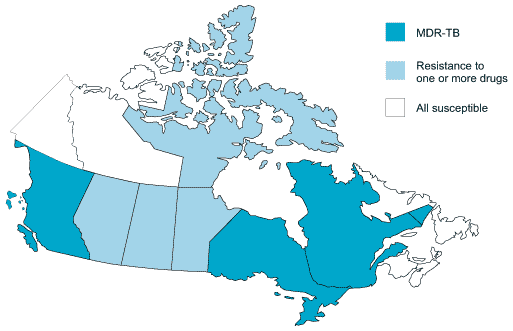
Figure 2
Reported MTB isolates in Canada by province/territory - 2000 (n = 1,464)
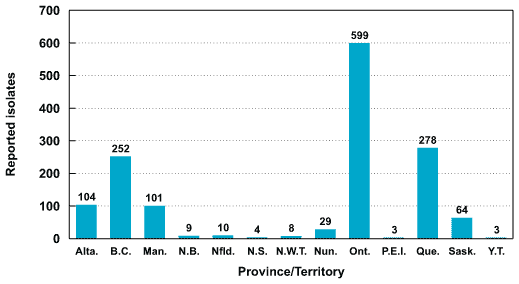
Figure 3
Overall pattern of reported TB drug resistance in Canada - 2000
(n = 164/1,464 total isolates)
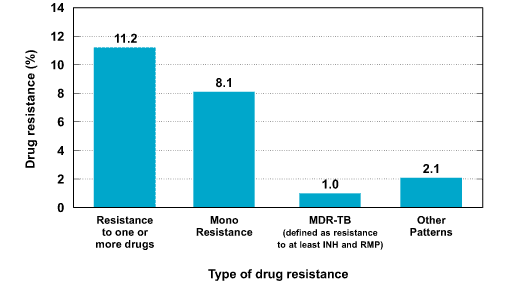
Figure 4
Reported TB drug resistance in Canada by type of drug - 2000
(n = 164/1,464 total isolates)
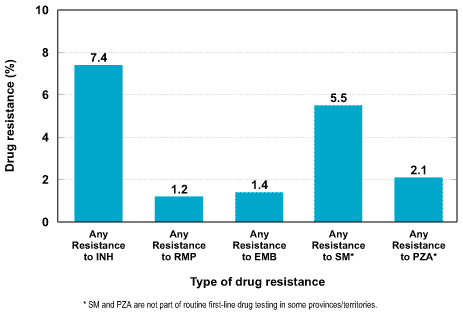
Figure 5
Reported TB drug resistance in Canada by gender and year of birth - 2000
(n = 164/1,464 total isolates)
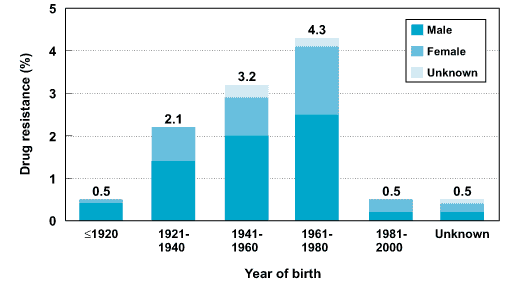
 HOW TO REACH US
HOW TO REACH US
For more information, copies of this report or other reports, please contact:
Tuberculosis
Prevention and Control
Centre for Infectious Disease Prevention and Control
Public Health Agency of Canada
Health Canada
Room 0108 B, Brooke Claxton Building
Tunney's Pasture, Ottawa, Ontario K1A 0K9
Internal Postal Address: 0900B-1
Telephone:
(613) 941-0238
Facsimile: (613) 946-3902
The following text, figures and tables were prepared by:
Penny Nault
Tuberculosis Database Manager
Tuberculosis Prevention and Control
Melissa Phypers,
MSc
A/Chief
Tuberculosis Prevention and Control
 ACKNOWLEDGEMENT
ACKNOWLEDGEMENT
Tuberculosis Prevention and Control would like to acknowledge the members of the Canadian Tuberculosis Laboratory Technical Network and their teams for their contribution to and their participation in the Canadian Tuberculosis Laboratory Surveillance System (CTBLSS).
Published by authority of the Minister of Health
© Her Majesty the Queen in Right of Canada, represented by the Minister of Public Works and Government Services Canada, 2002.
Cat.
H49-110/2001
ISBN 0-662-66495-7
This publication can
be made available in alternative formats.

